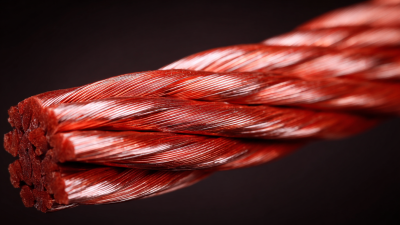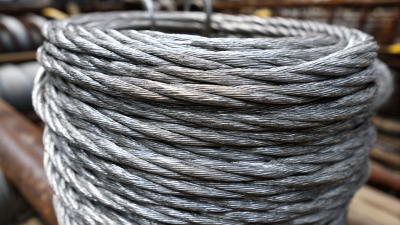
-
Home
-
Products
-
PVC Cable Material
-
Low Smoke Zero Halogen Cable Material
-
Cable material
-
Optical fiber cable
-
-
About Us
-
VR
-
News
-
Blog
-
Contact Us
Leave Your Message

In the rapidly evolving landscape of electrical applications, the demand for materials that offer not only performance but also safety and reliability has become paramount. One such innovative solution is the Lszh Irradiated Insulating Cable Material. This advanced cable insulation technology is gaining traction among manufacturers and engineers, driven by a surge in regulations addressing fire safety and environmental standards. According to market research, the global demand for low smoke zero halogen (LSZH) materials is expected to reach $2.5 billion by 2027, highlighting the growing recognition of their benefits.

The unique properties of Lszh Irradiated Insulating Cable Material make it a preferred choice for high-performance electrical applications across various industries, including transportation, telecommunications, and construction. Studies have shown that LSZH materials significantly reduce toxic smoke and harmful emissions during combustion, thereby enhancing safety in enclosed spaces. Furthermore, the irradiation process enhances the thermal and mechanical properties of the cable, enabling it to withstand higher temperatures and reducing the risk of electrical failures. As we delve into the top five advantages of Lszh Irradiated Insulating Cable Material, it becomes clear that these attributes not only meet the current needs of the industry but also position them as a cornerstone for the future of safe and efficient electrical systems.
Low Smoke Zero Halogen (LSZH) irradiated insulating cable materials have gained significant traction in high-performance electrical applications due to their key benefits in electrical efficiency. One of the primary advantages is their reduced toxicity and low smoke emissions during combustion, which significantly enhances safety in enclosed environments, such as tunnels and high-rise buildings. According to a market analysis, the Transformer Insulation market is projected to reach USD 23.87 billion by 2027, reflecting the increasing demand for materials that prioritize both efficiency and safety in electrical systems.
Furthermore, LSZH materials exhibit excellent thermal and chemical resistance, which ensures longevity and reliability under extreme conditions. These properties are vital in industries that require stringent compliance with safety standards. Recent studies indicate that the adoption of LSZH cables can improve operational efficiency by up to 30% in high-demand settings, reducing energy waste and contributing to overall sustainability goals. This aligns with the global push towards greener technologies, where the integration of innovative materials like LSZH is pivotal.
LSZH (Low Smoke Zero Halogen) irradiated insulating cable materials are increasingly recognized for their enhanced fire safety features, particularly in high-performance electrical applications. One of the primary advantages of LSZH materials is their ability to emit minimal smoke and no halogen gases when exposed to fire. This characteristic is crucial in confined spaces such as tunnels, subways, and high-rise buildings where smoke inhalation poses significant risks to life and safety. The reduced smoke production allows for greater visibility and clearer escape routes during emergencies.
Moreover, LSZH materials are known for their excellent thermal stability and flame-retardant properties. These cables maintain structural integrity under extreme conditions, preventing the spread of flames and limiting damage to surrounding areas. The combination of low toxicity and effective fire resistance not only protects valuable equipment but also enhances overall system reliability. As electrical systems grow increasingly complex and integral to modern infrastructure, the adoption of LSZH irradiated insulating cable materials is pivotal in advancing safety standards while ensuring high performance in critical applications.
| Advantage | Description | Applications | Fire Safety Rating |
|---|---|---|---|
| Reduced Smoke Emission | Produces minimal smoke when exposed to fire, enhancing visibility and safety. | Subway systems, tunnels, and high-rise buildings. | Low Smoke Zero Halogen (LSZH) |
| Low Toxicity | Minimal release of toxic gases during combustion, protecting occupants. | Hospitals, schools, and residential buildings. | Non-Toxic |
| Excellent Thermal Stability | Maintains performance in high-temperature environments. | Industrial machinery, heating systems. | Thermal Resistance Class B |
| Mechanical Durability | Resistant to abrasion and impact, prolonging cable lifespan. | Manufacturing plants, construction sites. | Impact Resistant |
| Versatile Applications | Suitable for various environments, both indoor and outdoor. | Telecommunications, aerospace, and automotive industries. | UL & IEC Certified |
In the realm of high-performance electrical applications,
LSZH (Low Smoke Zero Halogen)
irradiated insulating cables stand out due to their superior thermal stability, making them ideal for extreme conditions.
These cables are engineered to withstand fluctuating temperatures and harsh environments without compromising their
insulation properties. The irradiated cross-linking process enhances the cables' resistance to heat, ensuring they maintain
integrity even under significant thermal stress. This feature is critical in applications like data centers,
transportation systems, and industrial machinery where reliability is paramount.
Tip: When selecting cables for extreme conditions, consider not just the
thermal stability but also the environmental factors that may affect performance. Check for additional certifications
that testify to the cable's resilience against heat, moisture, and chemicals to ensure a long-lasting installation.
Moreover, the low smoke and zero halogen characteristics of LSZH materials contribute to safer operational conditions.
In the event of fire, these cables release minimal smoke and no toxic halogen gases, protecting both human life and
sensitive equipment. Hence, they are extensively used in confined spaces like tunnels and public transport systems where
smoke mitigation is crucial.
Tip: Always ensure proper installation techniques are employed with LSZH cables
to maximize their thermal stability and safety benefits. This includes maintaining appropriate bend radii and avoiding
excessive mechanical stress which can compromise their structural integrity.
LSZH (Low Smoke Zero Halogen) irradiated insulating cable materials are making significant strides in high-performance electrical applications, particularly in their eco-friendly properties. The inherent design of LSZH materials minimizes harmful emissions during combustion, reducing the environmental impact often associated with traditional cable insulations. In settings where safety and ecological sustainability are paramount, LSZH materials offer a compelling alternative, ensuring that toxic smoke is kept to a minimum and allowing for safer environments in case of fire.
**Tip:** When selecting electrical cables for projects, consider opting for LSZH materials to align with corporate sustainability goals and compliance with stringent environmental regulations.
Additionally, LSZH insulation materials are highly resistant to abrasion and thermal aging, enhancing their longevity and reliability. This resilience not only prolongs the life of the cables but also diminishes waste, contributing to a more sustainable approach in electrical installations. By choosing LSZH irradiated insulating cables, industries can effectively tackle both performance requirements and environmental responsibilities.
**Tip:** Regularly assess the insulation materials used in your projects and opt for eco-friendly innovations that promise reduced carbon footprints without compromising on performance.
The improved durability and longevity of LSZH (Low Smoke Zero Halogen) irradiated insulating cable materials make them ideal for high-performance electrical applications, particularly in challenging environments. These cables are designed to withstand extreme conditions including temperature fluctuations and mechanical stress, making them suited for industries such as transportation, construction, and telecommunications. Their robust nature reduces the risk of cable failure, ensuring reliable operation and minimizing interruptions.
Recent developments in the industry have highlighted the commitment of manufacturers to enhance fire safety and processing efficiency. The introduction of advanced cable compounds promises not only to meet but to exceed new fire-resistance parameters. This innovation is crucial for ensuring that LSZH cables maintain their integrity and performance when exposed to fire hazards, thereby protecting both infrastructure and human life. Such advancements support the growing demand for safer, more durable materials in sectors facing increasingly stringent safety regulations and operational challenges.





